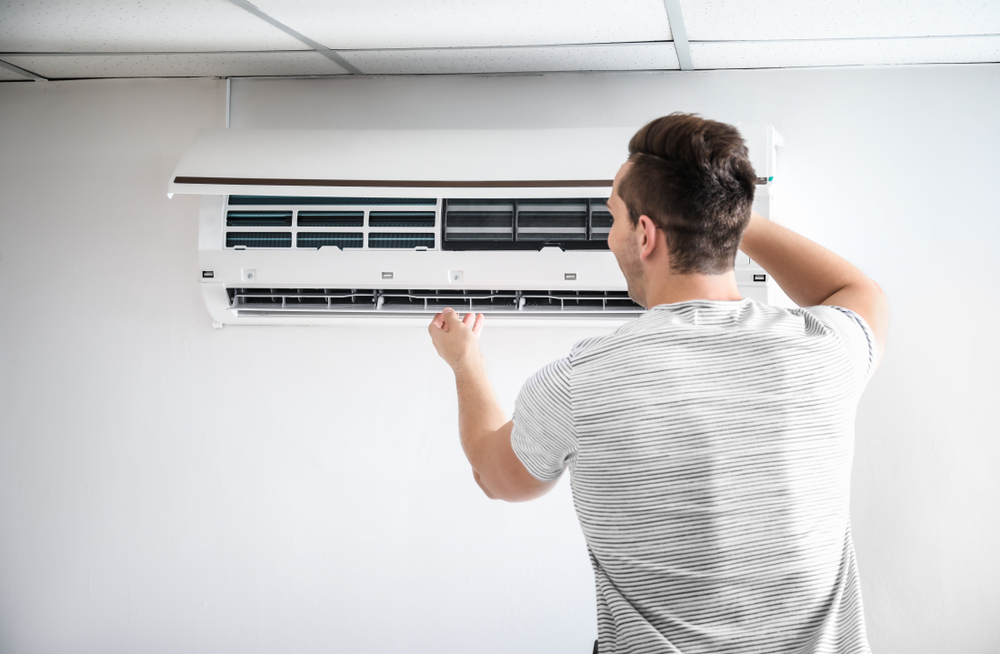
With the return of El Niño, the summer of 2023/24 is tipped to be one of our warmest in recent history. From homes to businesses, we all need to take a proactive approach and make sure that our properties are ready for the incoming heat.
Throughout this article, we are going to focus on one of the most versatile, effective and popular forms of air conditioning on the market – split systems. Split system air conditioners, often referred to as ductless air conditioners or mini-splits, have gained popularity for their ability to combine effective cooling, precise temperature control and a range of user-friendly features.
Wondering, ‘what is a split system air conditioner?’ It’s a solution that efficiently cools your space without the need for extensive ductwork. We will delve into all aspects, including the major components, benefits, and maintenance needs. If you’re in the market for new air con, we are here to help you make an informed decision that has you well prepared for any climate conditions.
To better understand how does split system air conditioners work, you need to have a clear picture of its core components. Let’s quickly explore them right now.
Indoor Unit (Evaporator): The indoor unit is typically mounted on a wall or ceiling inside the room you want to cool. It contains the evaporator coil, a fan, and the air filter. This unit is responsible for absorbing heat from the room’s air and circulating cool air back into the space.
These mounted indoor evaporators are the image that is most typically associated with the split system air conditioner. Depending on your individual needs and preferences, you can also have multiple mounted units installed.
Outdoor Unit (Condenser): Placed outside your home or building, the outdoor unit consists of a condenser coil, a compressor, and a fan. Its primary function is to release the heat absorbed from inside to the external environment.
Whether you’re adding an outdoor unit to a home, business or industrial space, you must have adequate room to do so. This is where the expert eye of HVAC professionals is very valuable. Once on site, an experienced split system installer will be able to quickly determine the best position and inform on how viable the follow-up installation will be.
Refrigerant Lines: These lines connect the indoor and outdoor units, allowing refrigerant (a special coolant) to circulate between them. The refrigerant absorbs heat from the indoor air and releases it outside, providing cooling.
Working behind the scenes, these lines play a critical role to the system’s overall functionality and efficiency. It is these components that allow modern split systems to achieve your desired temperature at the drop of a hat.
Control Panel and Remote: Whether you’re going with Daikin, Mitsubishi or any number of the leading brands, split system air conditioners all come with user-friendly control panels, which are found on the indoor unit, as well as a remote control. These allow you to set the desired temperature, fan speed, and mode (cooling, heating, dehumidifying, etc.).
One of the major advantages of more modern units is the introduction of smart device connectivity. From smart phone apps to intuitive cooling and power saving modes, these systems are purpose designed to be as user-friendly as possible. Here, you can even set up daily timers that seamlessly integrate with your routines and preferences.
Air Filters: Split systems are equipped with air filters that trap dust, allergens, and other particles from the indoor air. Regular cleaning or replacement of these filters is crucial for maintaining indoor air quality and system efficiency.
Today, split systems come with innovative in-built functions that specifically aim to filter the air quality. If you have allergies or asthma, these features are definitely a game changer. If this is a particular concern for you, we recommend checking with your HVAC provider, as they will be able to recommend a system that is asthma and allergy friendly.
Now that you have a better picture of the major components, we can now explore the numerous advantages of choosing a split system air conditioner.
Energy Efficiency: Split systems are known for their energy efficiency. In fact, it is one of the major reasons why they have become so popular and widely used throughout Australia. Unlike central air conditioning, which cools the entire house even if you’re using only one room, split systems allow you to cool specific zones or rooms, reducing energy consumption and utility bills.
Given that split systems are an all-in-one heating and cooling solution, they also save you from having to run multiple units at the one time. The vast majority of systems sold in Australia will come with a star rating; the more stars, the more efficient the unit will be. Again, if you’re still a little unsure or confused about the star rating index, this is another great time to speak with professionals.
Easy Installation: Installing a split system is relatively straightforward, particularly when directly compared to central air conditioning. It doesn’t require extensive ductwork, making it a cost-effective option for both new construction and retrofitting. Across the industry, installation costs also remain competitively priced.
There is a good reason why split systems are so popular and widespread. Ducted reverse cycle or gas, as we’ve noted, require adequate space for ductwork and other components. Split systems only require a spot for the outdoor condenser and mounted unit. This is why they are often the best option for more compact apartments and commercial properties.
Whether you’re after split systems in Ringwood, Kew or Essendon, Assolute Airflow have a team of Melbourne wide installers that are ready to assist. Reach out to us for a free quote today!

Zoning Flexibility: Split systems offer individual temperature control for each indoor unit, allowing you to achieve the perfect level of comfort levels in different rooms. This zoning flexibility can lead to greater comfort and energy savings.
From homes to workplaces, zoning caters to individual preferences and helps to avoid arguments about who has control over the temperature. If you’ve ever worked in an office, you’ll know just how much debate this can spark.
Of course, zoning technology also works perfectly in homes where the temperature tends to fluctuate from room to room, be it living spaces with little to no natural light or bedrooms directly exposed to the hot afternoon sun.
Whisper Quiet Operation: Split system air conditioners are known for their quiet operation. The noisy components, such as the compressor and condenser, are located outdoors, minimising indoor noise levels.
Many split systems come with initiative night modes and other low noise settings that will make you forget that they are even on. Primarily, night mode functions are designed to allow you to sleep with minimal disruption, whilst also using less energy. Translation – a win win!
Improved Indoor Air Quality: With built-in air filters, split systems help improve indoor air quality by trapping dust, allergens, and pollutants. This is especially beneficial for anyone with allergies or respiratory issues.
This is an area where brands are continually competing against one another, which as a byproduct, has led to some amazing technological innovations. Ultimately, you should be able to enjoy the benefits of year-round heating and cooling without sudden hayfever and asthma flare ups.
While many older models tended to blow air in a straight line, newer systems come with in-built technology to provide a more even and subtle distribution across the entire room. Daikin’s Coanda Airflow, for example, offers even and consistent cooling.
Heating Capability: While there are a large number of cooling only models, an equally large number offer both cooling and heating. This, therefore, makes them a versatile year-round solution. In Melbourne, the ability to adapt to unpredictable climate conditions is a must.
On average, split system air conditioning is also a more cost-effective means of heating than ducted gas. However, it is important to note that large expansive homes may require some form of central heating to achieve the necessary level of coverage.
Remote Control Convenience: The included remote control allows you to adjust settings from the comfort of your couch or bed, making it convenient to fine-tune the temperature and fan speed.
Since the introduction of smart devices and apps, managing the temperature is now easier than ever before. This means that if you’re on the way home from work on a scorching summer day, you can set the temperature ahead of time and get relief the moment you step through the door.
While generally low maintenance, split systems still require work to operate efficiently over time. From core to technical components and smart devices, regular maintenance is essential. Here’s 4 quick tips for maintaining your split system:
If you own split systems in Camberwell, Coburg or any corner of Melbourne, don’t hesitate to get in touch for professional maintenance. Our technicians are fully insured, accredited and down-to-earth. Get a free quote today.
As you can see, split system air conditioners offer a wide range of benefits, from energy efficiency to individual comfort and improved indoor air quality. If you’re looking to make the switch, or move on from an outdated model, Absolute Airflow is the number one name to trust for all things split systems in Melbourne.
Reach out to us today on 03 7036 9149 for further information.

© Copyright 2025 - Absolute Airflow - All Rights Reserved